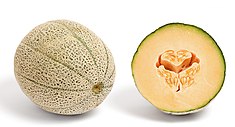

| Cantaloupe | |
|---|---|

European cantaloupe (true cantaloupe)
| |
| Genus | Cucumis |
| Species | C. melo |
| Subspecies | C. melo subsp. melo |
| Cultivar group | Cantalupensis Group (incorporating Reticulatus Group)[1] |

The cantaloupe (/ˈkæntəloʊp/ KAN-tə-lohp) is a type of food; a true melon (Cucumis melo) from the family Cucurbitaceae. Originally, cantaloupe referred only to the non-netted, orange-fleshed melons of Europe, but today may refer to any orange-fleshed melon of the C. melo species,[2] including the netted muskmelon which is called cantaloupe in North America, rockmelon in Australia and New Zealand, and spanspek in Southern Africa. Cantaloupes range in mass from 0.5 to 5 kilograms (1 to 11 lb).
The name cantaloupe was derived in the 18th century via French cantaloup from The Cantus Region of Italian Cantalupo, which was formerly a papal county seat near Rome, after the fruit was introduced there from Armenia.[3] It was first mentioned in English literature in 1739.[2] The cantaloupe most likely originated in a region from South Asia to Africa.[2] It was later introduced to Europe, and around 1890, became a commercial crop in the United States.[2]
Melon derived from use in Old Frenchasmeloun during the 13th century, and from Medieval Latin melonem, a kind of pumpkin.[4] It was among the first plants to be domesticated and cultivated.[4]
The South African English name spanspek dates back at least as far as 18th-century Dutch Suriname: J. van Donselaar wrote in 1770, "Spaansch-spek is the name for the form that grows in Suriname which, because of its thick skin and little flesh, is less consumed."[5] A common etymology involves the Spanish-born Juana María de los Dolores de León Smith, who ate canteloupe for breakfast while her husband and 19th-century governor of Cape Colony, Sir Harry Smith, ate bacon and eggs; the fruit was termed Spanish bacon (Afrikaans Spaanse spek) by locals as a result.[6][7] However, the term had been in use long before that point.

Cantaloupe in cross-section
| |
| Nutritional value per 100 g (3.5 oz) | |
|---|---|
| Energy | 141 kJ (34 kcal) |
8.16 g | |
| Sugars | 7.86 g |
| Dietary fiber | 0.9 g |
0.18 g | |
0.82 g | |
| Vitamins | Quantity %DV† |
| Vitamin A equiv. | 26% 232 μg26% 32 μg |
| Thiamine (B1) | 4% 0.049 mg |
| Riboflavin (B2) | 2% 0.027 mg |
| Niacin (B3) | 4% 0.694 mg |
| Pantothenic acid (B5) | 2% 0.085 mg |
| Vitamin B6 | 2% 0.04 mg |
| Folate (B9) | 4% 14 μg |
| Vitamin C | 12% 10.9 mg |
| Vitamin K | 2% 2.7 μg |
| Minerals | Quantity %DV† |
| Calcium | 1% 9 mg |
| Iron | 2% 0.38 mg |
| Magnesium | 3% 13 mg |
| Manganese | 2% 0.046 mg |
| Phosphorus | 1% 17 mg |
| Potassium | 5% 157 mg |
| Sodium | 1% 30 mg |
| Zinc | 4% 0.44 mg |
| Other constituents | Quantity |
| Water | 90.2 g |
| †Percentages estimated using US recommendations for adults,[8] except for potassium, which is estimated based on expert recommendation from the National Academies.[9] | |
The European cantaloupeortrue cantaloupe, C. melo var. cantalupensis, is lightly ribbed with a sweet and flavorful flesh and a gray-green skin that looks quite different from that of the North American cantaloupe.[2]
The North American cantaloupeormuskmelon, C. melo var. reticulatus, common in the United States, Mexico, and some parts of Canada, is a different variety of C. melo, a melon with a reticulated ("net-like") peel.[2] It is a round melon with firm, orange, moderately sweet flesh.
In 2016, global production of melons, including cantaloupes, totaled 31.2 million tons, with China accounting for 51% of the world total (15.9 million tons).[10] Other significant countries growing cantaloupe were Turkey, Iran, Egypt, and India producing 1 to 1.9 million tons, respectively.[10]
California grows 75% of the cantaloupes in the US.[11]
Cantaloupe is normally eaten as a fresh fruit, as a salad, or as a dessert with ice cream or custard. Melon pieces wrapped in prosciutto are a familiar antipasto. The seeds are edible and may be dried for use as a snack.
Because the surface of a cantaloupe can contain harmful bacteria—in particular, Salmonella[12]—it is recommended that a melon be washed and scrubbed thoroughly before cutting and consumption to prevent risk of Salmonella or other bacterial pathogens.[13]
A moldy cantaloupe in a Peoria, Illinois, market in 1943 was found to contain the highest yielding strain of mold for penicillin production, after a worldwide search.[14][15]
Raw cantaloupe is 90% water, 8% carbohydrates, 0.8% protein and 0.2% fat (table). In a reference amount of 100 grams (3.5 oz), raw cantaloupe supplies 140 kJ (34 kcal) of food energy, and is a rich source (20% or more of the Daily Value, DV) of vitamin A (29% DV) and a moderate source of vitamin C (13% DV). Other micronutrients are in negligible amounts (less than 10% DV) (table).
In general, the FDA recommends thoroughly washing and scrubbing the rinds of all cantaloupes and melons prior to cutting and slicing, and to keep sliced melons refrigerated prior to eating.
Then the Peoria researchers made yet another breakthrough. Searching for a superior strain of Penicillium, they found it on a moldy cantaloupe in a Peoria garbage can. When the new strain was made available to drug companies, production skyrocketed.
|
| |||||||
|---|---|---|---|---|---|---|---|
| Benincasa |
| ||||||
| Citrullus |
| ||||||
| Cucumis |
| ||||||
| Other species |
| ||||||
| See also |
| ||||||
| |||||||
| Cucumis melo var. cantalupensis |
|
|---|---|